It is often asked: what is the optimal chain length for a bicycle with derailleurs? Should a new chain be shortened and how much? That is answered in this post. For single speed bicycles (or bikes with internal gear hubs), see: Determining optimal single speed chain length.
Table Of Contents (T.O.C.):
- Bicycle drive chain length
- The importance of determining the correct chain length
- Chain length sizing for bicycles with derailleurs
- Rear derailleur chain wrap capacity not big enough
- Shortening and re-connecting bike chains
TL/DR
Here, I explain:
- Why it’s important to cut your chain to the optimal length?
- How to measure that (before cutting 🙂 ) for 1-X vs double and triple crank drivetrains?
- What can you do if your chain is too long for your RD cage to handle?
1. Bicycle drive chain length
A new bicycle chain usually comes with 116 links. This is long enough for the biggest chainrings and for most distances of rear wheel from front chainrings. So for optimal length a new chain is usually shortened from the 116 links that come in the box. In rare occasions – touring frames for example, with extremely long chainstays, 116 links might not be long enough, so a few links off another new chain need to be added to reach optimal chain length.
2. The importance of determining the correct chain length
Too long chain will increase risk of chain dropping, while too short chain puts too much stress on the drivetrain, or can damage it, if it can be put and closed over the chainrings in the first place. Chain that is too short can also damage rear derailleur.
3. Chain length sizing for bicycles with derailleurs
There are several methods for getting the chain at the correct length. The method explained here is certain to result in a chain long enough not to cause any drivetrain damage. The method is called “big-big”.
In order to make absolutely sure the chain is long enough, it should be put around the biggest chainring in the front, the biggest sprocket at the rear and then add one more inch, i.e. one link because of the derailleur (one link consists of a pair of outer and inner plates, as shown in the picture below – it is often referred to as “two links”). When measuring, the chain is not put through the rear derailleur, the derailleur is moved so it doesn’t get in the way.
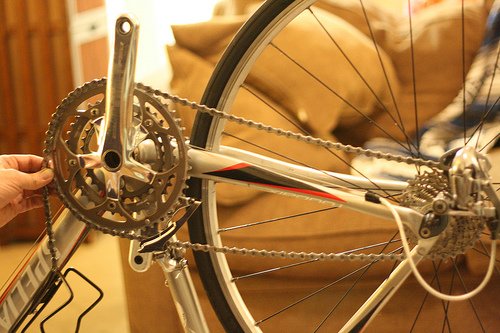
This makes the chain one inch longer to accommodate the rear derailleur.
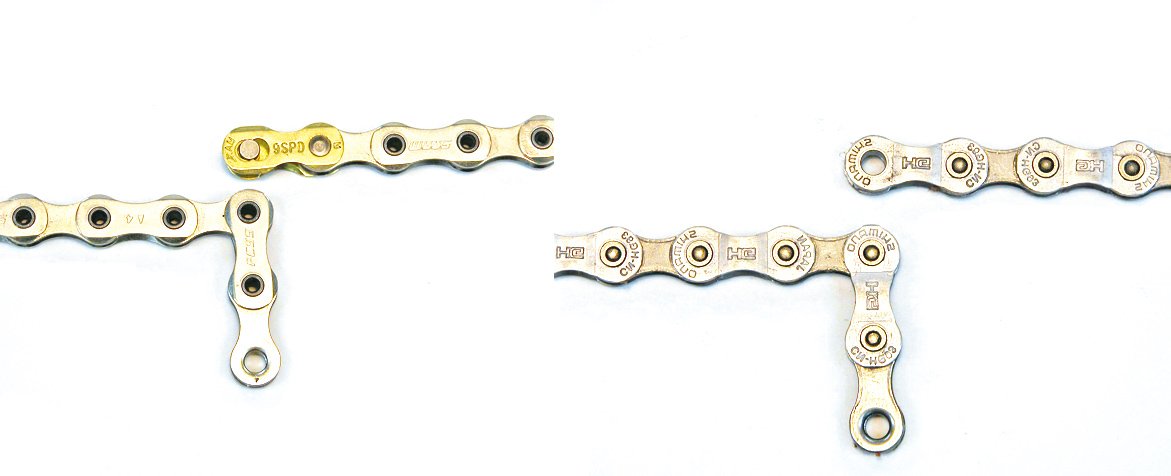
On the left is a chain with a quick link, while on the right is a “standard” chain using a connecting pin.
For bicycles with rear suspension, the suspension should be totally bottomed – compressed when using this method. See the position of travel where the rear wheel is furthest away from the cranks. To achieve this with air shocks just let the air out, while for ones with spring one has to remove the shock, remove the spring, then put the shock back. Simpler, though not 100% reliable method is adding one extra pair of inner and outer links to the length determined by the method explained below.
With modern, more and more popular systems that have one chainring in the front and multiple chainrings in the back (“1x” systems), the optimal length is achieved when adding two extra links, instead of just one, after wrapping the chain around the only front chainring and the largest rear sprocket.
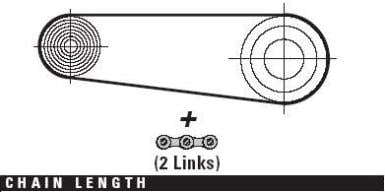
For bicycles that have more than one front chainring, i.e. those with a front derailleur.
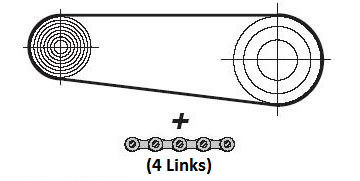
For bicycles with only one front chainring, i.e. without a front derailleur.
(see pros and cons of 1x drivetrains)
That’s all. A simple method. What to look out for?
Help BikeGremlin
stay online & independent
This website is educational, free, objective, and not commercial
(sponsors don’t enjoy paying if you mention all the product downsides that you notice 🙂 ).
How much does a WordPress website cost?
If you find this site to be good and helpful,
and if $5 per month is what you can afford to set aside,
please consider supporting my work with a Patreon donation:
4. Rear derailleur chain wrap capacity not big enough
Rear derailleur chain wrap capacity may not be big enough.
The explanation of what RD capacity is can be found under “Derailleur capacity” in this page: Rear derailleur.
This results in a situation that in a small-small chainring combination, the chain is too slack and can even fall off chainrings on bumpy roads.


Bottom part of the chain is rubbing the top RD jockey wheel.
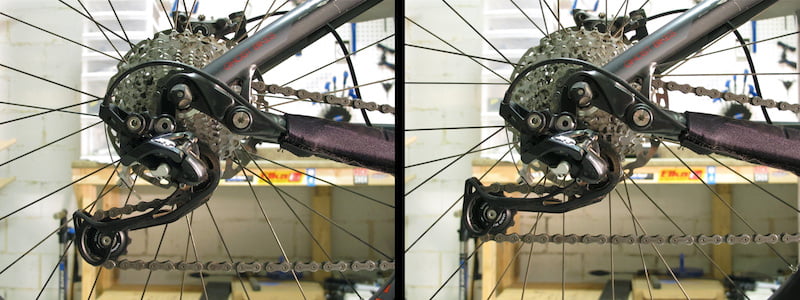
Chain to the right is still a bit too long for the RD wrap capacity, just not as extreme as in the two pictures above.
RD cage is parallel to the ground, making it hard for the RD to tighten the chain strongly enough.
This problem can be solved in three ways:
- Getting a rear derailleur with a longer cage.
- Avoiding smallest few sprockets at the cassette when the chain is on the smallest chainring in the front.
- Shortening the chain.
The third method is potentially dangerous, because in a big-big combination the chain will no longer be long enough. This can result in tearing the rear derailleur when changing to the biggest sprocket at the rear if the big chainring is used in the front.
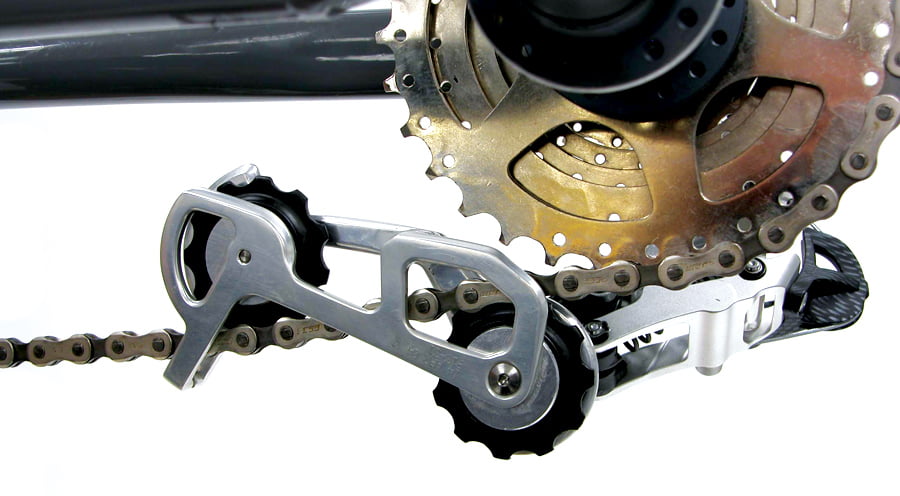
It managed to shift into big-big combo, but there is almost no bend at the derailleur jockey wheels.
Small-small and big-big combinations are combinations to avoid anyway, because the chain is cross-chained in those combos, the same gear ratio can be achieved with a middle-middle combination easily. Still, it can happen that in a moment of lesser caution, one does shift into one of those combinations. That is why, if method 1 is not possible for any reason (financial or some other), it is safer to use method 2 than method 3.
5. Shortening and re-connecting bike chains
For this, I’ve made a video demonstration:
Related post – How to lubricate a bicycle chain:

The existing comments posted under this article (questions and answers) have been moved to this BikeGremlin forum thread:
https://www.bikegremlin.net/threads/chain-length-sizing-for-bicycles-with-derailleurs-article-comments.124/


Or alternatively, I would wrap the new chain around the 38T chainring and 42T sprocket (instead of the 50T) and add the 2 extra links that I usually do?
Or wrap the new chain around the 38T chainring and 42T sprocket (instead of the 50T sprocket) and add two links, in the normal way?
Hi Relja.
Thanks for the confirmation.
Best wishes and many thanks,
I have a specialized cross trail bike that I modded to be a 27 speed as the original 18 2x front and 9x rear was to easy for me to ride. What length chain would I need for that?
Hi Paul,
It’ best to measure the chain on the bike – as explained in this article.
So, wrap the chain around the largest front and the largest rear chainring, then add 1″ (one pair of outer and inner plates, or three pins – however it’s easier to visualize).
As the chains are cut in 1″ (link pair) increments, in case you must choose between having 1.5″or 0.5″ longer, round up (to 1.5″, i.e. to three instead of two plates length, or 4 connecting pins).
Relja